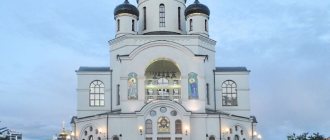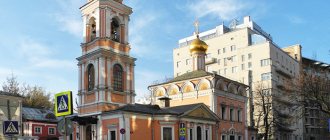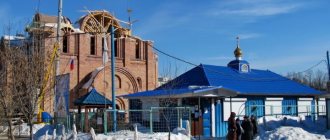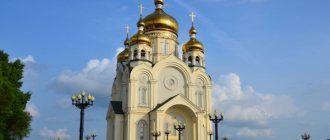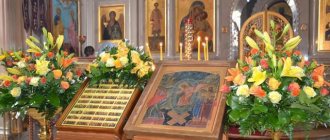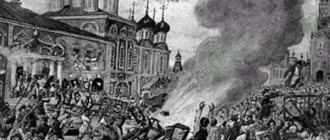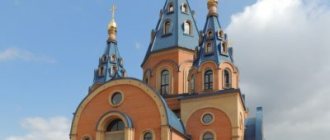Origin of the name of the temple and its meaning
The Church of John of Kronstadt in Zhulebino has a rather unusual dedication for Central Russia. According to church canons, the altar is consecrated in honor of a church holiday or a saint whose memory is celebrated on the day of consecration.
When in 1996, residents of the Moscow microdistrict Zhulebino sent a petition to His Holiness Patriarch Alexy II in order to found a church parish in their area, and then a temple, then after receiving consent they received a blessing to name the temple in honor of Xenia of Petersburg or John of Kronstadt .
Perhaps because the second name was more popular among Muscovites, the residents of Zhulebinsk chose this particular saint.
St. John of Kronstadt (Sergiev) (1829 – 1908) is a name that was recently discovered in the firmament of the Russian Orthodox Church, but this does not make his contribution to the development of Russian theological thought and spiritual pastoral activity any less significant.
A priest of the Russian Orthodox Church with the rank of mitred archpriest (the highest rank that a priest who does not wish to be promoted to the highest episcopal rank can be awarded), a native of the Arkhangelsk province, a native of a poor peasant family, who rose to the position of rector of the famous St. Andrew's Cathedral in Kronstadt and a member of the Holy Synod, in the meetings of which he refused to participate, one of the strongest spiritual authorities of his time was John of Kronstadt.
The Russian Orthodox Church abroad was the first to canonize John of Kronstadt as a saint on October 19, 1964, while in the USSR the very name and spiritual heritage of the shepherd remained under the strictest censorship.
Only in the last years of perestroika, on June 8, 1990, he was canonized as a saint and righteous of the Russian Orthodox Church (commemorated according to the calendar - December 20 and June 1 according to the Julian calendar).
Even in his youth, having chosen a spiritual path, John wanted to serve the faith following the example of the ancient missionaries.
He dreamed of going to the North, bringing the Christian faith to the indigenous peoples of the Russian North and America.
However, having plunged into the life of the urban lower classes of St. Petersburg, he realized how far his illusions were from real life, and how dedicated servants were needed here in Russia.
After being ordained to the rank of deacon, he received an appointment to the capital Kronstadt, which has long had the reputation of not only being a city of administrative exile for all politically unreliable elements, but also a city where all the poor and crippled were from time to time taken from imperial St. Petersburg.
The city of sailors, industrialists and shipowners, and at the same time - the city of poverty, misery and extreme vegetation, finally formed the goal of Father John's ministry.
Being only the third priest of the Kronstadt St. Andrew's Cathedral, he began active preaching and charitable activities. John of Kronstadt became famous for his deep emotional sermons, during which he himself, according to eyewitnesses, often cried.
He gave all his salary to the poor, often even giving it to his wife so that the family would not have to go hungry. However, this style of service of Father John met with disapproval from other clergy of the cathedral and from some of the Russian clergy, who believed that such demonstrative behavior was not befitting a clergyman.
At the same time, references to the healings he performed were recorded in his personal diary. Father John insisted on frequent communion and held public confessions, when everyone present in the church loudly proclaimed their sins so that they could be heard by others.
He slept no more than 3-4 hours a day, the rest of the time he devoted to visiting the houses of Kronstadt residents and traveling to St. Petersburg for the same purpose, and took confession in St. Andrew's Cathedral. As a rule, a great crowd of people wishing to receive absolution from Father John gathered for each such collective confession, and often the sacrament lasted from late evening until the morning service.
Many contemporaries noted that John was unpretentious in everyday life and led a very modest life. At the same time, he wore expensive clothes, embroidered robes, but did not choose the clothes himself and accepted them as gifts, wearing them only so as not to offend the donor by refusal.
By the way, it was not in vain that the temple in Moscow Zhelebino was dedicated in honor of John of Kronstadt. The pastor had a long history of relations with Moscow. Almost every month he was sure to visit the capital, as one of the priest’s admirers, N. Yastrebov, talks about in his diary published in exile.
Once a month, John arrived in the capital by morning train - to turn around one day, and together with his psalm-reader Pelds served in one of the Moscow churches. There were so many people who wanted to attend the service that entry for parishioners was by ticket only.
The “curator” of such visits was a friend of the priest, the merchant’s widow Sophia Burkhard - she determined where Father John would serve this time, as well as the list of houses that he visited and conducted the blessing of water there according to a shortened rite, to which he always added a few of his own prayers.
Hierarchy of the black clergy
The black clergy has its own rules:
The Patriarch is still considered the head of the Church. And the head of several dioceses is the Metropolitan. A diocese can be headed by a bishop or archbishop (for the largest dioceses). The abbot of a large monastery and the highest monastic rank is the Archimandrite. This status is given for special services to the Church. The abbot of the monastery, chosen by the hieromonks, is the abbot. Interestingly, a widower priest can also become an archimandrite after monastic tonsure. The inhabitants of the monasteries are Hierodeacons and Hieromonks.
- Patriarch
- Metropolitan
- Bishop
- Archimandrite/Hegumen
- Hierodeacon/Hieromonk.
There are other people in the Church who take part in worship, but are not classified as clergy:
- Altar boy
- Acolyte
- Sexton
- Reader
They do not have the grace of the priesthood.
There is no place for competition in the Church and division into higher and lower church ranks speaks only of special merits before God, the Church and people. Everyone has their place in the temple. Anyone can serve in a church as a reader or sexton if they make an effort.
Some of the clergy are also involved in caring for a certain group of people: the military, hospital and hospice patients. Regardless of their “specialization” and rank, the clergy of the Russian Orthodox Church performs important tasks.
Address to clergy:
As for appeals to priests, they exist official and unofficial. Unofficially, priests and deacons are usually called fathers: “Father George”, “Father Nikolai”, etc. Or simply “father”. On official occasions, the deacon is called “Your Reverence,” the presbyter “Your Reverence,” and the protopresbyter “Your Reverence.” When addressing a bishop, they say “Vladyka” (Vladyka George, Vladyka Nikolai). In the Russian Orthodox Church, when formally addressing a bishop, he is called “Your Eminence,” and an archbishop and metropolitan is called “Your Eminence.” The Patriarch is always addressed: “Your Holiness.” All these appeals relate not to the person’s personality, but to his ministry.
History of the Church of John of Kronstadt
As we said above, the decision to erect a temple in Zhulebino and create a church parish of the same name with it was made in 1996, and already in 1997 the first stone was laid in the foundation of the future temple. In June 1997, the site for the construction of the church was consecrated, and a cross was erected on the site of the future foundation.
On December 26, 1998, the minor consecration of the temple took place, and Archpriest Matthew Stadnyuk served the first service. A year later, in September 1999, His Holiness Patriarch Alexy II of Moscow and All Rus' himself personally performed the Great Consecration of the temple.
Iconostasis in the Church of John of Kronstadt in Zhulebino
The construction process took 9 years. The process was completed in 2006, and after another 2 years the connection of all communications and commissioning was completed. On January 10, 2009, Archbishop Arseny (Istrinsky) of Moscow consecrated a new iconostasis, the creation of which was specially timed to celebrate the anniversary of the founding of the parish.
The design of the temple and its stylistic design are interesting. It is based on the “octagon on quadrangle” structure typical of Russian sacred architecture. The structure is made of timber, but is installed on a brick basement, raised high above the ground.
The building has an elongated rectangular shape and consists of an oblong refectory and a single-tier bell tower. The church porch, as well as the top of the bell tower, are decorated with figuratively carved pillars.
Current status of the Church of St. John of Kronstadt
The Church of John of Kronstadt in Zhulebino became the property of the parish community in 2008. Today, the duties of the rector are priest Dmitry Arzumanov, who has done extremely much for the cultural and social development of the parish.
Archpriests Vyacheslav Gorobets and Sergiy Biryukov, priests Sergius Sirotin, Timofey Chaikin and Dimitry Safonov help him in his ministry. Almost the entire clergy of the temple devoted many years to spiritual service; many clergy have awards and honorary titles for their diligent work for the benefit of the spiritual enlightenment of the people.
The parish is part of the Moscow City Diocese, the South-Eastern Vicariate, and the Blachernae Deanery.
| Name | Church of St. Righteous John of Kronstadt in Zhulebino |
| Architecture type | Church, eight on four |
| Date of foundation | 1996 |
| Construction of the last building | 2006 |
| Architect | E. Vorontsova |
| Ecclesiastical jurisdiction | Russian Orthodox Church of the Moscow Patriarchate |
Temple complex in Cheryomushki
On the territory of Moscow, in the Cheryomushki district, there is a beautiful temple complex of All Saints, whose heavenly patron is John the Wonderworker of Kronstadt.
The complex was erected in 2021, and consecrated in 2021. Today, daily services are held within its walls, church sacraments and rituals are performed. The church in Cheryomushki can simultaneously accommodate up to 500 people.
In the temple complex there is a Sunday educational group named after. A.V. Suvorov and the pilgrimage center. In addition, there is a social service here that provides assistance to the homeless, disabled people, large families and people who, by the will of fate, find themselves in difficult life circumstances.
The temple complex is located at the address: Moscow, Cheryomushki district, st. Novocheremushkinskaya, 85a.
This is interesting! The history of the icon: Recovering the dead and how it helps.
Interesting facts and legends
In 2015, when Russia solemnly celebrated the 25th anniversary of the canonization of John of Kronstadt, the first monument to the saint in Moscow was erected in Zhulebino to commemorate this event.
The author of the sculpture, which was erected in the courtyard of the temple, was the Belarusian master Andrei Golubev.
It took a year to cast the sculpture, and to make the image as authentic as possible, the master used photographs and portraits of John of Kronstadt during his lifetime.
At one time, when choosing the name of the temple, the Zhulebinsk parish unanimously decided that the altar of the temple would be consecrated in honor of the newly glorified Saint and Righteous John of Kronstadt, preferring it to Xenia of St. Petersburg.
Let us recall that both Xenia and John, although they belong to the host of the most revered saints in Rus', albeit relatively “young” saints, still their cult has regional characteristics and is more widespread in the North of Russia, in St. Petersburg and adjacent regions.
John of Kronstadt himself, by the way, is a historically rather ambiguous person. Even his contemporaries did not treat him equally, and in both the liberal and conservative press of that time one can find a lot of criticism of the pastor’s style of ministry, his way of life, and his alleged love of luxury and posturing.
Another unexpected side of the life of John of Kronstadt is that he was an inveterate monarchist, conservative, one of the ideological inspirers and creators of the Black Hundred Union of the Russian People.
Another inexplicable phenomenon - the theological legacy of John of Kronstadt is considered the pinnacle of Russian theological thought of the 19th century, which is compared with such great figures as Sergius Bulgakov, G. Florovsky, P. Florinsky, S. Averintsev and others.
Don’t miss the most popular article in the section: Optina Pustyn Monastery - how to get there from Moscow, address, where it is located, history and interesting facts.
Shrines of the Church of John of Kronstadt
The Church of John of Kronstadt in Zhulebino has its own shrines, which, like its patron, attract large crowds of pilgrims.
This is a particularly revered icon of the Mother of God, pieces of relics and sacred relics:
- Icon of the Mother of God “Three Hands” - its history is directly related to the iconoclastic movement in Byzantium - this image was one of the few rescued from Syria. The first copy of the icon came to Russia under Patriarch Nikon - several of the oldest copies are to this day in churches and monasteries in Moscow. The icon is also known for the fact that it was in front of it that the royal family prayed on their last night in the house of the merchant Ipatiev in Yekaterinburg before being executed in 1918.
- A piece of the belt of the hieromartyr Philumen the Holy Sepulchre , abbot of the monastery at Kladez Ioann near Jerusalem, who was brutally murdered in 1979.
- Particles of the relics of Russian saints - the Venerable Optina Elders, St. Demetrius of Rostov, Motrona of Moscow, Great Martyrs Elizabeth and Barbara, Great Martyr Panteleimon.
Znamenny chant
In our church, once a month on Saturdays, services are held in the Old Russian Znamenny chant, which was sung in Rus' until the 17th century. Now this is how they sing in some churches and monasteries, as well as in communities of the same faith. This singing came to us from Byzantium along with the Christian faith, sung by everyone in one voice according to the “hooks” - signs (banners), which took their development from various stresses over the Church Slavonic text. Znamenny singing is especially conducive to prayer and has healing properties for the soul.
You can find out more about the znamenny chant on the website of Father Paul (Korotkikh) and listen to the ipakoi on our YouTube channel.
Sunday School
The church clergy keeps up with the times and introduces parishioners of all ages to church life. These goals are served by the Sunday school at the church, or rather, even two, “Bethany,” which educates preschoolers and school-age children, and an “adult” school - after all, adults often need even more competent pastoral direction.
Children's Sunday school "Bethany", which is led by Fr. Sergius Sirotin, was founded in 2009. Its name was not chosen by chance - it was Bethany, a village located near Jerusalem, according to legend, that was one of the favorite places of Jesus Christ, where his devoted followers lived, and where he spent the last few days of his life. earthly life.
Today, the school holds weekly classes on Saturdays for children of preschool and school age; there are 3 lessons per day, lasting from 30 to 45 minutes. Children are divided into groups according to age. The program for each group is adapted to the age needs of the children. Preschoolers study from 9:30 to 11:30, schoolchildren from 12:00 to 14:30.
For very young children, a school was recently created, with classes held three times a week. After classes, all children are offered a group breakfast or tea party. Classes are held at st. Aircraft designer Mil, 1.
At school, children are taught the basics of courses such as:
- foundations of the Orthodox faith;
- saints of the Church;
- art;
- Church Slavonic language;
- God's law.
In the creative workshop, children not only train creative thinking, learn handicrafts, crafts, and develop their imagination, but also develop a value perception of nature and the surrounding world.
Where is
Address
Kronstadt Square, 2
Metro
- Avenue of Veterans
- Leninsky Prospekt
- "Avtovo"
How to get there
- If you are interested in how to get there on foot from the Prospekt Veteranov metro station, then you first need to go to Dachny Prospekt, cross the road and move left. Walk along the avenue all the way to Kronstadt Square, there you turn right, and the temple will be in front of you. From the Prospekt Veteranov metro stop, you can get to the Leni Golikova stop by minibus No. 650A or by bus No. 486 and walk about 900 meters.
- If you are coming from the Leninsky Prospekt metro station, you need to go out onto Leninsky Prospekt itself, cross the road, turn left and walk all the way to Kronstadt Square. Turn right there and you'll end up next to the temple. You can also get from the Leninsky Prospekt Metro stop to the Kronstadt Square stop by bus No. 26, 87, 142, by trolleybus No. 32, 35, 45 or by minibus No. 35, 43, 45, 87, 103, 142, 226, 242, 339, 420 to the Kronstadt Square stop and walk about 100 meters.
- If you are moving from the Avtovo metro station, you need to go out to Avtovskaya Street, walk to Kronstadt Street and walk along it all the time. Then cross Marshal Kazakov Street, turn left, walk to Stachek Avenue and move along it to Kronstadt Square. Cross the road there and you will find yourself at the temple. From the Avtovo Metro stop, you can get to the Solomakhinsky Proezd stop by minibus No. 401A or tram No. 36, 41, 52 and walk just under 400 meters. You can also get there from the Prospekt Stachek stop by minibus No. 655.
Children's choir school
The Church of John of Kronstadt in Zhulebino is not only a vibrant spiritual, but also a cultural and youth center of the entire microdistrict. Through the efforts of the rector of the church, Archpriest Dmitry Arzumanov, the youth organization “Lestvitsa”, a youth movement, and also a school for children’s choral singing were founded here.
Church singing has long been one of the most powerful aesthetic components of the Russian Orthodox Church. In addition to its enormous prayer significance, it is also a highly complex system of musical theoretical knowledge.
In 2011, a church singing school was founded at the church. Its task is to prepare children for singing in the choir, but in addition to church music disciplines, the school program includes solfeggio, musical literature, choir, piano - that is, students are given a secondary music education according to the Children's Music School program.
Intensive vocal training includes training in church singing, voice training, choral singing and vocal ensemble classes.
Project of the Church of the Presentation of the Lord
The temple community has another project - to erect a stone Church of the Presentation of the Lord, the first consecrated foundation stone of which was laid in 2011. The temple is planned to be built as a one-story building, but on a high ground floor.
It is planned to locate a baptismal place, household and utility rooms in the basement. The powerful and spacious floor will be divided into 3 parts - the narthex, the central nave and the altar. A traditional octagonal dome in a tent style will rise above the temple.
The base is a reinforced concrete structure. The ground floor will be decorated with natural stone, the walls will be covered with painted plaster. The roof on the project is covered with copper, and the crosses and domes are gilded. In terms of capacity, the temple will be designed for almost 1,000 people.
Pilgrimage trips
The Ladder youth movement is actively working at the temple, which, among other things, organizes pilgrimages to Orthodox shrines.
Members of the “Lestvitsa” also help with attending patriarchal services, raise funds for the restoration of monasteries and churches, hold charity fairs and markets, and organize leisure activities for the youth of the parish.
Address, how to get to the temple
The temple is located on the street. Saranskaya, 1, you can always check the opening hours and schedule of services by calling +7 (495) 704-53-13. It is easy to get to the temple from anywhere in Moscow, despite the fact that the Zhulebino microdistrict is located 2 km from the Moscow Ring Road.
To do this, you need to get to the Zhulebino metro station and to the street. General Kuznetsov, or to the Lermontovsky Prospekt station, from which you should exit on the opposite side. Schedule of services
The church in Zhulebino has its own schedule of liturgies and services. Liturgies and prayer services are served according to a certain schedule, and the schedule of weekday services differs from the holiday one.
From Monday to Saturday, Matins and Liturgy are served at 8 o'clock, the evening service begins at 17:00. On Sundays and holidays, the morning prayer service in the Church of St. John of Kronstadt begins at 7:00, after 3 hours the festive liturgy begins, and the all-night vigil begins at 17:00.
Article design: Vladimir the Great
For May 2021
| 1 Saturday | Watch. Vespers with Liturgy of St. Basil the Great. | 8.00 |
| Reading the Acts of the Holy Apostles. | 22.30 | |
| Midnight Office. | 23.20 |
| 0.00 | |
| Watch. Liturgy of St. John Chrysostom. | 8.00 |
| Great Vespers. | 18.00 |
| 8.00 | |
| Great Vespers. | 18.00 |
| 8.00 | |
| Great Vespers. | 18.00 |
| 8.00 | |
| Great Vespers. | 18.00 |
| 8.00 | |
| Great Vespers. | 18.00 |
| 8.00 | |
| Vespers | 18.00 |
| 8.00 | |
| All-night vigil. | 18.00 |
| 6.30 | |
| Watch. Liturgy. | 9.00 |
| Matins. Akathist. | 18.00 |
| 8.00 | |
| Vespers. Matins. | 18.00 |
| 6.30 | |
| Watch. Liturgy. | 9.00 |
| Vespers. Matins. | 18.00 |
| 8.00 | |
| Vespers. Matins with polyeleos. | 18.00 |
| 8.00 | |
| Vespers. Matins. | 18.00 |
| 8.00 | |
| Vespers. Matins. | 18.00 |
| 8.00 | |
| All-night vigil. | 18.00 |
| 6.30 | |
| Watch. Liturgy. | 9.00 |
| Matins. Akathist. | 18.00 |
| 8.00 | |
| Vespers. Matins. | 18.00 |
| 8.00 | |
| Vespers. Matins. | 18.00 |
| 8.00 | |
| Vespers. Matins. | 18.00 |
| 8.00 | |
| All-night vigil. | 18.00 |
| 8.00 | |
| All-night vigil. | 18.00 |
| 8.00 | |
| All-night vigil. | 18.00 |
| 6.30 | |
| Watch. Liturgy. | 9.00 |
| Matins with polyeleos. | 18.00 |
| 8.00 | |
| Vespers. Matins. | 18.00 |
| 8.00 | |
| Vespers. Matins. | 18.00 |
| 8.00 | |
| Vespers. Matins. | 18.00 |
| 8.00 | |
| Vespers. Matins. | 18.00 |
| 8.00 | |
| Vespers. Matins. | 18.00 |
| 8.00 | |
| All-night vigil. | 18.00 |
| 6.30 | |
| Watch. Liturgy. | 9.00 |
| Matins. Akathist. | 18.00 |
| 8.00 | |
| Vespers. Matins. | 18.00 |

